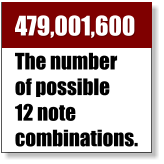This is a great question that I get asked from time to time. In this post we will look at 6 great ways to create guitar scales.
But before we get into the 6 techniques, we need to cover a bit of background…
Music has been around for a very, very long time. Ethnomusicologists have found that music was present in even the most primitive tribal cultures. No one so far has been able to determine exactly when music began.
Different cultures use different pitch systems whereby they divide the octave differently than we do in the West. In Western culture we divide the octave into 12 equal divisions. This is known as equal temperament. For comparison, it’s quite common for instruments in India to divide the octave into 22 parts. The Slendro scale, which is common in Indonesia, divides the octave into 5 parts of which we can only accurately play the first note with our equal tempered tuning.
With the 12 notes we have available to us in the West, there are 479,001,600 possible arrangements! So yes there are lots of possibilities, however, you will be pretty hard pressed to discover a guitar scale that has never been used or conceived before.
The first thing to understand about guitar scales is that a scale is simply a collection of pitches that have been arranged into a specific ascending and descending order. Usually, the ascending and descending forms of the scale are the same, but this is not a requirement. There are some scales where the ascending form is actually different than the descending.
Scales can have as few as 4 notes in them or can have all 12 (this is called the chromatic scale). Seven note scales (heptatonic scales) are the most common in the West.
Here are 6 ways to create guitar scales.
First check out a good comprehensive guitar scales book such as my book, the World of Scales: A Compendium of Scales for the Modern Guitar Player. Play through all of the scales and mark off all of the scales you like the sound of. Once you’ve identified the scales you like, commit them to memory and start to create some melodies, guitar solos and songs.
Second you can work it out manually yourself. This is a much longer way to go. All you would do is grab a stack of paper and write out the notes C D E F G A B C. Next, begin to add sharps and then flats and then combinations of the two. This method becomes more of a mathematical exercise than a musical one. Once you’re finished, play through your results.
Another way of doing this is to just use numbers. So you would take the scale degrees that you want, for example 1 2 3 4 5 6 7 and then you would start to add sharps and or flats. So you could start with 1 b2 3 4 5 6 7; 1 b2 b3 4 5 6 7; etc.
Third, you can start with a chord you want to play a melody over. You take the chord tones and write them down. Next you experiment with the notes that are not part of the chord. Write down the ones that you like and presto—you’ve got a scale. Again, chances are pretty good that the scale you come up with will already have a name.
Fourth, drop out notes from an existing scale you know. Let’s say you take a C minor scale and drop out the 4th and the 7th notes. The result would be C D Eb G Ab C. This creates a very cool sounding scale. It’s a Japanese pentatonic (5 note) scale called the Hirajoshi scale.
Fifth, add in notes to an existing scale you know. Let’s say you start with an A minor pentatonic scale: A C D E G A. Add a B to this and you get the following 6 note (hexatonic) scale: A B C D E G A.
Finally, let’s say you are looking for a dark sounding scale. Here’s what you do. Start with a C major scale. The notes in a C major scale are C D E F G A B C.
Now here’s the thing to keep in mind—as you add flats to the notes, the scale will sound darker. As you add sharps, the scale will sound brighter. Two scales that have a dark sound are C Db Eb F G Ab Bb C (this is called C Phrygian) and C Db Eb F Gb Ab Bb C (this is C Locrian).
To go the opposite way to create a bright sound you take the C major scale and raise the 4th degree. Your result is a bright sounding C Lydian : C D E F# G A B C.
Believe it or not, this just scratches the surface of scale creation.
So you can do it on your own with 100% pure experimentation. Or, you can learn some guitar scale theory to save yourself some time and then add in some experimentation. This will give you hundreds or even thousands of guitar scales at your disposal.
Have fun!
Don J MacLean










